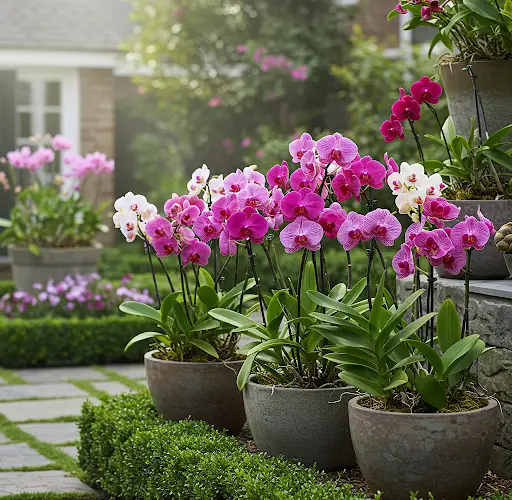A Simple and Effective Tip to Revive and Encourage Orchid Blooming
If you’re new to orchid cultivation and are struggling with an orchid that’s not blooming or is showing signs of poor health—like yellowing leaves or lack of new flowers—don’t worry! With the right care and a simple homemade fertilizer, you can restore your orchid’s health and promote beautiful blooms. In this guide, we’ll walk you through an easy and affordable technique to bring your orchid back to life and encourage it to flower.
Why Orchids May Struggle to Bloom
Orchids can sometimes become sluggish or stop blooming if they are not receiving the right nutrients or if they are being exposed to improper environmental conditions. Common problems include insufficient sunlight, incorrect watering, or lack of the right nutrients. Orchids are sensitive plants that need precise care, and one of the most important factors for their growth and blooming is proper fertilization.
The Simple Fertilizer for Orchid Revival
For this method, we will use an easy-to-make fertilizer using vitamin B complex, which is affordable and accessible. Research has shown that B vitamins, especially B1 (thiamine), B3 (niacin), and B6 (pyridoxine), play an important role in the health and growth of orchids. They promote root growth, leaf development, and encourage blooming. A study conducted in the UK by researcher Leandro Salmoura confirmed that small quantities of these vitamins significantly benefit orchids in their blooming and growth cycles.
Ingredients:
-
1 tablet of B Complex (any brand available at pharmacies or supermarkets)
-
5 drops of vinegar (any type)
-
1 liter of water
Steps for Preparation:
-
Crush the B Complex Tablet: Start by taking one tablet of B complex. You can use any brand, as they all provide the same essential B vitamins needed for your orchid’s health. Crush the tablet until it becomes a fine powder.
-
Add Vinegar: Next, add approximately 5 drops of vinegar to the crushed tablet. Vinegar acts as a catalyst, helping the nutrients from the B complex tablet to break down more effectively and be absorbed by the plant.
-
Mix with Water: Add the mixture to 1 liter of water. Stir thoroughly to ensure that the powder is well dissolved, creating a uniform solution.
-
Apply to the Orchid: Once mixed, you can apply the solution to your orchid. Simply water the orchid with this nutrient-rich solution, ensuring that it reaches the roots. It’s best to apply the fertilizer directly to the soil rather than spraying it on the plant’s leaves.
Benefits of This Fertilizer for Orchids
This simple fertilizer formula provides orchids with the essential nutrients needed for strong roots, healthy foliage, and vibrant blooms. The B vitamins help with root growth, stimulate new shoots, and improve flower production. The addition of vinegar helps in the rapid absorption of these nutrients by the plant.
By using this mixture once a month, your orchid will gradually recover and start to show signs of new growth. After three months of regular application, you will likely see a significant improvement in both the health and flowering of your orchid.
Additional Care Tips for Healthy Orchids
While the fertilizer helps your orchid thrive, there are a few other care tips that are important for ensuring consistent blooms:
-
Sunlight: Orchids need indirect sunlight, ideally from the morning sun. Direct afternoon sunlight can burn the delicate leaves and prevent flowers from blooming. Be sure to place your orchid in a location where it can get the soft, diffused light it needs to flourish.
-
Watering: Orchids do not like to be overwatered. A general rule of thumb is to water your orchid once a week, but it’s important to check the soil’s moisture level before watering. The soil should dry out slightly between waterings to avoid root rot.
-
Temperature and Humidity: Orchids prefer temperatures between 60-75°F (15-24°C) and thrive in a humid environment. If the air in your home is dry, you can increase humidity by placing a tray of water near the orchid or using a humidifier.
-
Potting and Repotting: Orchids should be repotted every 1-2 years to refresh the growing medium and prevent root overcrowding. When repotting, make sure to use a well-draining orchid mix and avoid using regular garden soil, which retains too much moisture.
Conclusion
With just a simple and affordable homemade fertilizer, you can help revive your orchid and encourage it to bloom beautifully. By following these easy steps and caring for your orchid with the right amount of light, water, and nutrients, you’ll soon have a flourishing plant full of vibrant flowers. Patience is key, and within a few months, you’ll be amazed at the transformation of your orchid, which will be stronger, healthier, and full of beautiful blossoms.
This easy-to-make fertilizer is not only effective for orchids but can also be used for other plants, making it a versatile and cost-effective solution for plant care.



